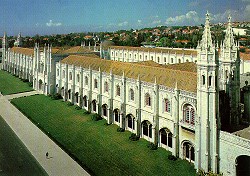
Das Museu Nacional de Arqueologia in Lissabon wurde 1893 unter dem Namen 'Museu Ethnologico' gegründet. Die Sammlung ägyptischer Altertümer, die zum Museum gehört, besteht aus mehr als 500 Objekten, von denen 309 in der ständigen Ausstellung zu sehen sind. Die Sammlung, die die größte ihrer Art in Portugal ist, wurde über die letzten achtzig Jahre hinweg zusammengetragen. 1909 brachte Professor Leite de Vasconcelos, der Gründer des Museums, 70 Objekte aus Ägypten mit, die hauptsächlich in die vorgeschichtliche und die Griechisch-Römische Zeit datierten. Die portugiesische Königin Amelia kaufte 1903 in Ägypten weitere 200 Objekte, die im Nationalmuseum für Antike Kunst und in den Palästen von Ajuda und Necessidades, alle in Lissabon, aufbewahrt wurden, bis sie dem Museum übergeben wurden. Der Rest der Sammlung besteht aus Stiftungen mehrerer privater Sammler wie den Familien Palmela, Bustorff Silva und Barros e Sá.
Die ausgestellten Objekte sind nach thematischen und chronologischen Gesichtspunkten angeordnet und reichen von der Vorgeschichte bis in die Koptische Zeit, decken also eine 5000jährige Geschichte ab. Jede der vierzehn Abteilungen hat einen kurzen Erklärungstext in derselben Reihenfolge wie im Katalog Antiguidades Egípcias I (1993).
Die erste Abteilung zeigt vorgeschichtliches Material wie Handbeile, Paletten, Feuersteinmesser und Keramik der Naqada-Zeit. Die zweite Abteilung enthält Steingefäße, hauptsächlich aus Alabaster, und umfaßt alle Epochen. Die nächste Abteilung ist eine kleine Gruppe von Objekten des täglichen Lebens wie Sandalen, Perlenketten, Ringe, Armreifen und Kosmetikutensilien. In Abteilung Vier gibt es Grabstelen und Steininschriften, darunter eine mit einer Kartusche mit dem Thronnamen Ramses' IX. Die nächste Abteilung enthält verschiedene Statuetten, darunter eine schöne Büste aus der Spätzeit; ihr folgt die Abteilung der Uschebti, die hauptsächlich in die 21. Dynastie datieren. Abteilung Sieben enthält eine kleine Gruppe von Votivstatuetten, Abteilung Acht Amulette, und Abteilung Neun ist den Skarabäen gewidmet. Die nächste Abteilung gilt der Mumifizierung, wo es zwei Sarkophage, eine menschliche Mumie, Tiermumien und Grabbeigaben, etwa ein sehr schönes Bootsmodell, gibt. In der elften Abteilung werden Grabkegel ausgestellt, und die zwölfte behandelt Bronzestatuetten, darunter einige der wichtigsten Gottheiten des alten Ägypten. Die beiden letzten Abteilungen betreffen die Griechisch-Römische bzw. die Koptische Zeit.
Diese Sammlung, auch wenn sie keinen beeindruckenden Umfang aufweist, zeigt einen sehr guten Querschnitt der künstlerischen und der Alltagsproduktion einer der erstaunlichsten Zivilisationen der Welt, des alten Ägypten.